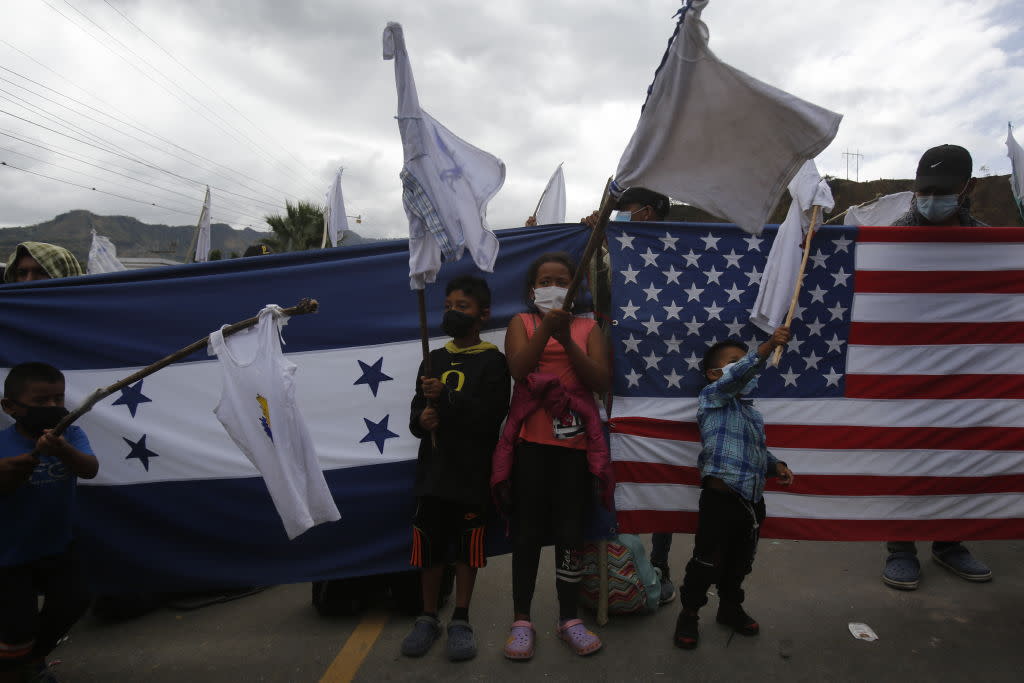Joe Biden's Immigration Bill Aims to Address the Root Causes of Migration. Will it Work?

- Oops!Something went wrong.Please try again later.
Migrants, who arrived in caravan from Honduras to try to make their way to the United States, wait at the border in Vado Hondo, Guatemala, on January 18, 2021. Credit - Photo by Luis Vargas/Anadolu Agency via Getty Images
On his first day in office, President Joe Biden sent an immigration bill to Congress filled with goals that are a far cry from the Trump Administration’s hardline policies. Along with proposals for a pathway to citizenship for undocumented immigrants who meet certain qualifications, Biden’s bill plans to address the deeper goal of addressing the root causes of migration, particularly from Central America. However, while it is a loftier in its aims in how to tackle immigration, experts say that it will take a lot more than is being proposed to address the issues that cause immigration from the region.
Biden’s bill comes after a caravan of thousands of Honduran migrants heading north to the U.S. was dissipated by Guatemalan security forces. Biden Administration officials warned migrants not to make the journey to the U.S., but experts believe people from Honduras, El Salvador and Guatemala will keep attempting to migrate to safer locations such as the U.S. as they have in recent years because of the dire situations they continue to face in their home countries.
Through the U.S. Citizenship Act of 2021, Biden has put forth a $4 billion four-year plan that aims to decrease violence, corruption and poverty in El Salvador, Guatemala and Honduras, the home countries of many of the migrants who have arrived at the U.S.-Mexico border to seek asylum in recent years. The bill would also establish centers throughout Central America for people to pursue refugee resettlement in either the U.S. or other countries.
Though the $4 billion is an increase in investment compared to the Trump and Obama Administrations, Ariel Ruiz Soto, a policy analyst at the Migration Policy Institute, says that $4 billion over the course of four years alone will not be enough to tackle the underlying issues. Investment from the U.S. needs to coincide with partnerships with the governments of Central American countries and Mexico, he says, and include special attention to education and jobs for youth, not just emphasis on security and enforcement measures, as was done under Trump and Obama. Improving economies could allow for people to have a stable future in their home countries, causing migration to decrease in the long run, possibly decades from now.
“[$4 billion] is an upgrade, and it will have significant consequences,” Ruiz tells TIME. “But it is only going to be effective if it’s sustainable over decades…it can’t be just four years, it can’t be eight years, it has to be sustained.”
It’s also an effort the U.S. should not undertake alone, Ruiz adds. Mexican President Andrés Manuel López Obrador also supports investing in Central America. López Obrador has worked with the U.S. and Canada on similar efforts made to address the root causes of migration in Central America, and in 2018 the U.S. backed Mexico by investing $5.8 billion. However, much of that money was already previously committed, according to The New York Times. “The United States by no means needs to be the only one doing this work,” Ruiz says. “What will make it more successful is if Mexico and the U.S. are speaking with the same voice about investment in the region.”
Any plan for investment should also cater to the specific needs of each country, Ruiz says. For example, 47% of Guatemalan children under the age of five suffer from chronic malnutrition according to the World Bank, and Guatemala ranks ninth in the world for level of risk to the effects of climate change, meanwhile in Honduras, 48% of people live in poverty and there is a high level of violence.
Investment by the U.S. and Mexico also means engaging with the private sector to create job opportunities in the Northern Triangle, Ruiz adds.
“Now that the new president (Biden) is here we are waiting for the answer, all of us immigrants who are here from Honduras,” one Honduran man, 18-year-old Eber Sosa who was in the caravan this week, told the Associated Press. “We are looking to see what the new president says to move forward.”
Violence continues to be high in Honduras and El Salvador, though homicide rates have been decreasing steadily, and Guatemalans face high unemployment, poverty and malnutrition. Hondurans were particularly devastated by hurricanes Eta and Iota in November. The three countries have also suffered economically as a result of COVID-19.
Ian Kysel, visiting assistant clinical professor of law at Cornell Law School and co-director of the Asylum and Convention Against Torture Appellate Clinic, says he sees this effort by Biden as a first step in creating a regional immigration policy grounded in human rights. “Going back decades, the U.S. Government has failed to adequately invest in making rights and human dignity the cornerstone of U.S. policy in the region—on migration or otherwise,” he tells TIME in a statement. “Human rights are key to addressing the major challenges facing migration. Past administrations have heavily invested in deterrence and securitization, forcefully externalizing the U.S. border to the detriment even to those seeking protection from persecution.”
But whether $4 billion does end up being allocated to Central America depends on Congress. On Wednesday, U.S. Senator Bob Menendez, a Democrat from New Jersey, announced he would be the one to introduce Biden’s bill. Menendez was one of the so-called “Gang of Eight” Senators who led the push for comprehensive immigration reform in 2013, an effort by former President Barack Obama to provide a pathway to citizenship for undocumented immigrants that ultimately failed in the House.

